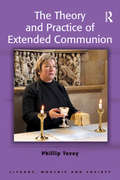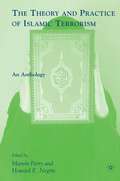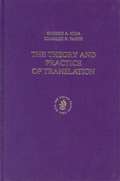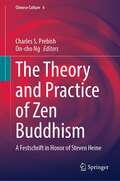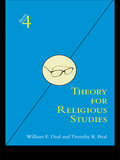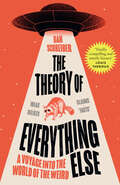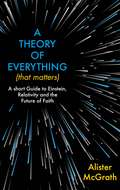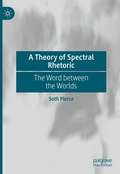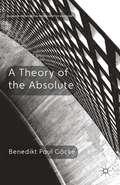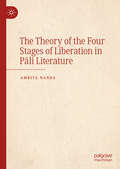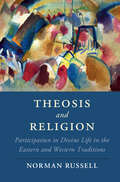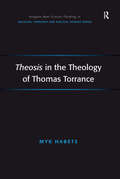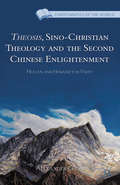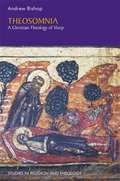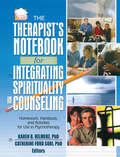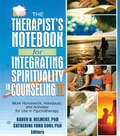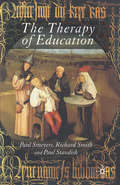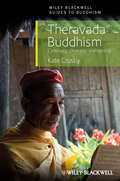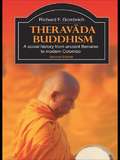- Table View
- List View
The Theory and Practice of Extended Communion (Liturgy, Worship and Society Series)
by Phillip ToveyThree churches have recently produced liturgies for 'extended communion'. This is the distribution of previously consecrated elements at a public service by lay people or a deacon in the absence of a priest. This development began in the Roman Catholic Church with the Vatican 'Directory on Sunday Worship in the absence of a priest' in 1988. The Methodist Church produced a service of Extended Communion in 1999, and the Church of England authorized 'Public Worship with Communion by Extension' in 2001. In this book Phillip Tovey examines these churches to discover the reasons for the production of these services and their theological rationale. An in-depth examination of case studies draws conclusions highly relevant to the wider church.
The Theory and Practice of Extended Communion (Liturgy, Worship and Society Series)
by Phillip ToveyThree churches have recently produced liturgies for 'extended communion'. This is the distribution of previously consecrated elements at a public service by lay people or a deacon in the absence of a priest. This development began in the Roman Catholic Church with the Vatican 'Directory on Sunday Worship in the absence of a priest' in 1988. The Methodist Church produced a service of Extended Communion in 1999, and the Church of England authorized 'Public Worship with Communion by Extension' in 2001. In this book Phillip Tovey examines these churches to discover the reasons for the production of these services and their theological rationale. An in-depth examination of case studies draws conclusions highly relevant to the wider church.
The Theory and Practice of Islamic Terrorism: An Anthology
by Howard E. Negrin M. PerryThis is the first anthology designed to enhance the reader's understanding of the multiple dimensions of Islamic terrorism by presenting a cross-section of recent articles and selections from cutting-edge books on the subject.
The Theory and Practice of Translation (PDF)
by Eugene Nida Charles TaberThe Theory and Practice of Translation, first published in 1982 and a companion work to Toward a Science of Translating (Brill, 1964), analyses and describes the set of processes involved in translating. Bible translating, the focus of this work, offers a unique subject for such a study, as it has an exceptionally long history, involves more than 2,000 languages, a vast range of cultures and a broader range of literary structures than any other type of translating. Not only of interest to Biblical scholars, therefore, this work explores issues of textual meanings and the procedures for communicating these meanings into other languages and cultures.
The Theory and Practice of Zen Buddhism: A Festschrift in Honor of Steven Heine (Chinese Culture #6)
by Charles S. Prebish On-Cho NgThis book brings together an impressive group of scholars to critically engage with a wide-ranging and broad perspective on the historical and contemporary phenomenon of Zen. The structure of the work is organized to reflect the root and branches of Zen, with the root referring to important episodes in Chan/Zen history within the Asian context, and the branches referring to more recent development in the West. In collating what has transpired in the last several decades of Chan/Zen scholarship, the collection recognizes and honors the scholarly accomplishments and influences of Steven Heine, arguably the most important Zen scholar in the past three decades. As it looks back at the intellectual horizons that this towering figure in Zen/Chan studies has pioneered and developed, it seeks to build on the grounds that were broken and subsequently established by Heine, thereby engendering new works within this enormously important religio-cultural scholarly tradition. This curated Festschrift is a tribute, both retrospective and prospective, acknowledging the foundational work that Heine has forged, and generates research that is both complementary and highly original. This academic ritual of assembling a liber amicorum is based on the presumption that sterling scholarship should be honored by conscientious scholarship. In the festive spirit of a Festschrift, this anthology consists of the resounding voices of Heine and his colleagues. It is an indispensable collection for students and scholars interested in Japanese religion and Chinese culture, and for those researching Zen Buddhist history and philosophy.
Theory for Religious Studies (theory4)
by William E. Deal Timothy K. BealIn this handy volume, two professors of religious studies provide the student of religious studies - whether the motivated undergraduate, graduate student, or professor - with a brief review of theorists' work from the perspective of religious studies. For example, in 5-10 pages, the reader will get a review of Emmanuel Levinas's work as it offers insights for scholars in religious studies, followed by a selected bibliography. In short, this is a guide for students of religious studies that will take major theoretical writers in the humanities and social sciences and explain their relevance to the study of religion.
Theory for Religious Studies (theory4)
by William E. Deal Timothy K. BealIn this handy volume, two professors of religious studies provide the student of religious studies - whether the motivated undergraduate, graduate student, or professor - with a brief review of theorists' work from the perspective of religious studies. For example, in 5-10 pages, the reader will get a review of Emmanuel Levinas's work as it offers insights for scholars in religious studies, followed by a selected bibliography. In short, this is a guide for students of religious studies that will take major theoretical writers in the humanities and social sciences and explain their relevance to the study of religion.
The Theory of Everything Else
by Dan SchreiberThis is not a book of facts; it’s a book of ‘facts’. Should you finish it believing we became the planet’s dominant species because predators found us too smelly to eat; or that the living bloodline of Christ is a family of Japanese garlic farmers – well, that’s on you. Why are we here? Do ghosts exist? Did life on Earth begin after a badly tidied-up picnic? Was it just an iceberg that sank the Titanic? Are authors stealing their plotlines from the future? Will we ever talk to animals? And why, when you’re in the shower, does the shower curtain always billow in towards you? We don’t know the answers to any of these questions. But don’t worry, no matter what questions you have, you can bet on the fact that there is someone (or something) out there, investigating it on your behalf. From the sports stars who use cosmic energy to office plants investigating murders, The Theory of Everything Else will act as a handbook for those who want to think differently.
A Theory of Everything (That Matters): A Short Guide to Einstein, Relativity and the Future of Faith
by Alister McGrathOn 29th May 1919, British astronomers tested Einstein's theory of relativity by measuring the path of the stars travelling near the sun during an eclipse. On 7th November 1919, the results of that experiment were announced in London, proving Einstein's theory of relativity. A Theory of Everything (that Matters) has been written in celebration of this 100th anniversary. With the confirmation of Einstein's theories at the beginning of the twentieth century, our understanding of the universe became much more complex. What does this mean for religious belief, and specifically Christianity? Does it mean, as so many people assume, the death of God? In A Theory of Everything (that Matters) Alister McGrath - Professor of Science and Religion at Oxford University - explores these questions, giving an overview of Einstein's thought and scientific theories, including his nuanced thinking on the difference between the scientific enterprise and beliefs outside its realm. This groundbreaking book is for anyone intrigued by Einstein as one of the twentieth century's most iconic figures, who wants to know what his theories mean for religion, and who is interested in the conversation between science and religions more broadly.'An excellent study of Einstein's theories in relation to his beliefs about God' - starred review in PUBLISHERS WEEKLY
A Theory of Spectral Rhetoric: The Word between the Worlds
by Seth PierceThis book synthesizes Jacques Derrida’s hauntology and spectrality with affect theory, in order to create a rhetorical framework analyzing the felt absences and hauntings of written and oral texts. The book opens with a history of hauntology, spectrality, and affect theory and how each of those ideas have been applied. The book then moves into discussing the unique elements of the rhetorical framework known as the rhetorrectional situation. Three case studies taken from the Christian tradition, serve to demonstrate how spectral rhetoric works. The first is fictional, C.S. Lewis ’The Great Divorce. The second is non-fiction, Tim Jennings ’The God Shaped Brain. The final one is taken from homiletics, Bishop Michael Curry’s royal wedding 2018 sermon. After the case studies conclusion offers the reader a summary and ideas future applications for spectral rhetoric.
A Theory of the Absolute (Palgrave Frontiers in Philosophy of Religion)
by Benedikt Paul GöckeA Theory of the Absolute develops a worldview that is opposed to the dominant paradigm of physicalism and atheism. It provides powerful arguments for the existence of the soul and the existence of the Absolute. It shows that faith is not in contradiction to reason.
The Theory of the Four Stages of Liberation in Pāli Literature
by Amrita NandaThis book investigates the origins and development of the theory of four stages of liberation in Pāli literature. This theory is an important soteriological cartography in early Buddhism, particularly Theravāda Buddhism. Amrita Nanda challenges the traditional interpretation of the four stages by recognizing the impact of the changing socio-religious factors on the theory’s origins and subsequent development. Based primarily on the Pali literary sources, this study utilizes sometimes-overlooked aspects of these texts. This book first traces the origins of each stage individually; then, it traces the formation of the theory and its subsequent development.
Theosis and Religion: Participation in Divine Life in the Eastern and Western Traditions (Cambridge Studies in Religion, Philosophy, and Society)
by null Norman RussellTheosis, originally a Greek term for Christian divinisation or deification, has become a vogue word in modern theology. Although recent publications have explored its meaning in a selection of different contexts, this is the first book to offer a coherent narrative of how the concept of theosis developed in both its Eastern and Western versions. Norman Russell shows how the role of Dionysius the Areopagite was pivotal, not only in Byzantium but also in the late mediaeval West, where it strengthened the turn towards an individualistic interiority. Russell also relates theosis to changing concepts of religion in the modern age. He investigates the Russian version of theosis, introduced in the West by Russian members the Paris School after the 1917 Revolution. Since then, theosis has undergone additional development through the addition of esoteric elements which have since passed into the mainstream of all theological traditions and even into popular spirituality.
Theosis in the Theology of Thomas Torrance (Routledge New Critical Thinking in Religion, Theology and Biblical Studies)
by Myk HabetsTorrance's vision of Theosis (deification/divinisation) is explored through his doctrine of creation and anthropology, his characterisation of the incarnation, his accounts of reconciliation and union with Christ, and his theology of church and sacraments. Myk Habets' study distinguishes Torrance's Reformed vision of theosis from other possible accounts of salvation as divinisation as they are found, for instance, within patristic thought and Eastern Orthodoxy. This book presents the first critique of the theology of T.F.Torrance to focus on theosis, and examines a model of theosis within the realm of reformed theology built upon Western theology.
Theosis in the Theology of Thomas Torrance (Routledge New Critical Thinking in Religion, Theology and Biblical Studies)
by Myk HabetsTorrance's vision of Theosis (deification/divinisation) is explored through his doctrine of creation and anthropology, his characterisation of the incarnation, his accounts of reconciliation and union with Christ, and his theology of church and sacraments. Myk Habets' study distinguishes Torrance's Reformed vision of theosis from other possible accounts of salvation as divinisation as they are found, for instance, within patristic thought and Eastern Orthodoxy. This book presents the first critique of the theology of T.F.Torrance to focus on theosis, and examines a model of theosis within the realm of reformed theology built upon Western theology.
Theosis, Sino-Christian Theology and the Second Chinese Enlightenment: Heaven and Humanity in Unity (Christianities of the World)
by A. ChowFor a millennium and a half in China, Christianity has been perceived as a foreign religion for a foreign people. This volume investigates various historical attempts to articulate a Chinese Christianity, comparing the roles that Western and Latin forms of Christian theology have played with the potential role of Eastern Orthodox theology.
Theosomnia: A Christian Theology Of Sleep
by Andrew BishopSleep occupies around one third of a person's life and is the subject of research across many disciplines. In this groundbreaking new monograph, Andrew Bishop explores sleep by creatively drawing on resources of the Christian tradition. Sleep is a subject which demands theological attention, because of the central place it occupies in contemporary reflection on what it is to be human. Offering original research, this book investigates sleep for the first time from a theological position, looking at all key questions that a theological treatment of sleep raises, including issues of identity and personhood, sleep and mortality, resurrection, and renewal and healing.
The Therapist's Notebook for Integrating Spirituality in Counseling I: Homework, Handouts, and Activities for Use in Psychotherapy
by Karen B. Helmeke Catherine Ford SoriLearn to initiate the integration of your clients’ spirituality as an effective practical intervention. A client’s spiritual and religious beliefs can be an effective springboard for productive therapy. How can a therapist sensitively prepare for the task? The Therapist’s Notebook for Integrating Spirituality in Counseling is the first volume of a comprehensive two-volume resource that provides practical interventions from a wide range of backgrounds and theoretical perspectives. This volume helps prepare clinicians to undertake and initiate the integration of spirituality in therapy with clients and provides easy-to-follow examples. The book provides a helpful starting point to address a broad range of topics and problems. The chapters of The Therapist’s Notebook for Integrating Spirituality in Counseling are grouped into five sections: Therapist Preparation and Professional Development; Assessment of Spirituality; Integrating Spirituality in Couples Therapy; Specific Techniques and/or Topics Used in Integrating Spirituality; and Use of Scripture, Prayer, and Other Spiritual Practices. Designed to be clinician-friendly, each chapter also includes sections on resources where counselors can learn more about the topic or technique used in the chapter—as well as suggested books, articles, chapters, videos, and Web sites to recommend to clients. Each chapter utilizes similar formatting to remain clear and easy-to-follow that includes objectives, rationale for use, instructions, brief vignette, suggestions for follow-up, contraindications, references, professional readings and resources, and bibliotherapy sources for the client. The first volume of The Therapist’s Notebook for Integrating Spirituality in Counseling helps set a solid foundation and provides comprehensive instruction on: ethically incorporating spirituality into the therapeutic setting professional disclosure building a spiritual referral source through local clergy assessment of spirituality the spirituality-focused genogram using spirituality in couples therapy helping couples face career transitions dealing with shame addiction recovery the use of scripture and prayer overcoming trauma in Christian clients and much more! The Therapist’s Notebook for Integrating Spirituality in Counseling is a stimulating, creative resource appropriate for any clinician or counselor, from novices to experienced mental health professionals. This first volume is perfect for pastoral counselors, clergy, social workers, marriage and family therapists, counselors, psychologists, Christian counselors, educators who teach professional issues, ethics, counseling, and multicultural issues, and students.
The Therapist's Notebook for Integrating Spirituality in Counseling I: Homework, Handouts, and Activities for Use in Psychotherapy
by Karen B. Helmeke Catherine Ford SoriLearn to initiate the integration of your clients’ spirituality as an effective practical intervention. A client’s spiritual and religious beliefs can be an effective springboard for productive therapy. How can a therapist sensitively prepare for the task? The Therapist’s Notebook for Integrating Spirituality in Counseling is the first volume of a comprehensive two-volume resource that provides practical interventions from a wide range of backgrounds and theoretical perspectives. This volume helps prepare clinicians to undertake and initiate the integration of spirituality in therapy with clients and provides easy-to-follow examples. The book provides a helpful starting point to address a broad range of topics and problems. The chapters of The Therapist’s Notebook for Integrating Spirituality in Counseling are grouped into five sections: Therapist Preparation and Professional Development; Assessment of Spirituality; Integrating Spirituality in Couples Therapy; Specific Techniques and/or Topics Used in Integrating Spirituality; and Use of Scripture, Prayer, and Other Spiritual Practices. Designed to be clinician-friendly, each chapter also includes sections on resources where counselors can learn more about the topic or technique used in the chapter—as well as suggested books, articles, chapters, videos, and Web sites to recommend to clients. Each chapter utilizes similar formatting to remain clear and easy-to-follow that includes objectives, rationale for use, instructions, brief vignette, suggestions for follow-up, contraindications, references, professional readings and resources, and bibliotherapy sources for the client. The first volume of The Therapist’s Notebook for Integrating Spirituality in Counseling helps set a solid foundation and provides comprehensive instruction on: ethically incorporating spirituality into the therapeutic setting professional disclosure building a spiritual referral source through local clergy assessment of spirituality the spirituality-focused genogram using spirituality in couples therapy helping couples face career transitions dealing with shame addiction recovery the use of scripture and prayer overcoming trauma in Christian clients and much more! The Therapist’s Notebook for Integrating Spirituality in Counseling is a stimulating, creative resource appropriate for any clinician or counselor, from novices to experienced mental health professionals. This first volume is perfect for pastoral counselors, clergy, social workers, marriage and family therapists, counselors, psychologists, Christian counselors, educators who teach professional issues, ethics, counseling, and multicultural issues, and students.
The Therapist's Notebook for Integrating Spirituality in Counseling II: More Homework, Handouts, and Activities for Use in Psychotherapy
by Karen B. Helmeke Catherine Ford SoriMore activities to tap into the strength of your clients’ spiritual beliefs to achieve therapeutic goals. The Therapist’s Notebook for Integrating Spirituality in Counseling II is the second volume of a comprehensive two-volume resource that provides practical interventions from respected experts from a wide range of backgrounds and theoretical perspectives. This volume includes several practical strategies and techniques to easily incorporate spirituality into psychotherapy. You’ll find in-session activities, homework assignments, and client and therapist handouts that utilize a variety of therapeutic models and techniques and address a broad range of topics and problems. The chapters of The Therapist’s Notebook for Integrating Spirituality in Counseling II are grouped into four sections: Models of Therapy Used in Integrating Spirituality; Integrating Spirituality with Age-Specific Populations: Children, Adolescents, and the Elderly; Integrating Spirituality with Specific Multicultural Populations; and Involving Spirituality when Dealing with Illness, Loss, and Trauma. As in Volume One, each clinician-friendly chapter also includes sections on resources where the counselor can learn more about the topic or technique used in the chapter—as well as suggested books, articles, chapters, videos, and Web sites to recommend to clients. Every chapter follows the same easy-to-follow format: objectives, rationale for use, instructions, brief vignette, suggestions for follow-up, contraindications, references, professional readings and resources, and bibliotherapy sources for the client. The Therapist’s Notebook for Integrating Spirituality in Counseling II adds more useful activities and homework counselors can use in their practice, such as: using religion or spirituality in solution-oriented brief therapy “Cast of Character” counseling using early memories to explore adolescent and adult spirituality cognitive behavioral treatment of obsessive-compulsive disorder age-specific clients such as children or the elderly multicultural populations and spirituality dealing with illness, loss, and trauma recovering from fetal loss creative art techniques with caregivers in group counseling and much more! The Therapist’s Notebook for Integrating Spirituality in Counseling II provides even more creative and helpful homework and activities that are perfect for pastoral counselors, clergy, social workers, marriage and family therapists, counselors, psychologists, Christian counselors, educators who teach professional issues, ethics, counseling, and multicultural issues, and students.
The Therapist's Notebook for Integrating Spirituality in Counseling II: More Homework, Handouts, and Activities for Use in Psychotherapy
by Karen B. Helmeke Catherine Ford SoriMore activities to tap into the strength of your clients’ spiritual beliefs to achieve therapeutic goals. The Therapist’s Notebook for Integrating Spirituality in Counseling II is the second volume of a comprehensive two-volume resource that provides practical interventions from respected experts from a wide range of backgrounds and theoretical perspectives. This volume includes several practical strategies and techniques to easily incorporate spirituality into psychotherapy. You’ll find in-session activities, homework assignments, and client and therapist handouts that utilize a variety of therapeutic models and techniques and address a broad range of topics and problems. The chapters of The Therapist’s Notebook for Integrating Spirituality in Counseling II are grouped into four sections: Models of Therapy Used in Integrating Spirituality; Integrating Spirituality with Age-Specific Populations: Children, Adolescents, and the Elderly; Integrating Spirituality with Specific Multicultural Populations; and Involving Spirituality when Dealing with Illness, Loss, and Trauma. As in Volume One, each clinician-friendly chapter also includes sections on resources where the counselor can learn more about the topic or technique used in the chapter—as well as suggested books, articles, chapters, videos, and Web sites to recommend to clients. Every chapter follows the same easy-to-follow format: objectives, rationale for use, instructions, brief vignette, suggestions for follow-up, contraindications, references, professional readings and resources, and bibliotherapy sources for the client. The Therapist’s Notebook for Integrating Spirituality in Counseling II adds more useful activities and homework counselors can use in their practice, such as: using religion or spirituality in solution-oriented brief therapy “Cast of Character” counseling using early memories to explore adolescent and adult spirituality cognitive behavioral treatment of obsessive-compulsive disorder age-specific clients such as children or the elderly multicultural populations and spirituality dealing with illness, loss, and trauma recovering from fetal loss creative art techniques with caregivers in group counseling and much more! The Therapist’s Notebook for Integrating Spirituality in Counseling II provides even more creative and helpful homework and activities that are perfect for pastoral counselors, clergy, social workers, marriage and family therapists, counselors, psychologists, Christian counselors, educators who teach professional issues, ethics, counseling, and multicultural issues, and students.
The Therapy of Education: Philosophy, Happiness and Personal Growth
by P. Standish P. Smeyers R. SmithThe idea of education as therapy goes back to ancient times. Today, it is understood that the role of the teacher comprises aspects of therapy directed towards the child. But to what extent should this relationship be developed, and what are its concomitant responsibilities? This book offers a challenging philosophical approach to these issues.
Theravada Buddhism: Continuity, Diversity, and Identity (Wiley-Blackwell Guides to Buddhism)
by Kate CrosbyTheravada Buddhism provides a comprehensive introductory overview of the history, teachings, and current practice of an often misunderstood form of one of the world’s oldest religious traditions. Explores Theravada Buddhism’s origins, evolution, teachings, and practices Considers the practice of Theravada beyond Sri Lanka and Thailand, by exploring a wealth of material from countries including Bangladesh, Cambodia, and Vietnam Reveals its rich and varied traditions, and corrects common misunderstandings about links to other practices, such as early Buddhism or Hinayana Buddhism Incorporates student-friendly features including a glossary and other study aids
Theravada Buddhism: Continuity, Diversity, and Identity (Wiley-Blackwell Guides to Buddhism)
by Kate CrosbyTheravada Buddhism provides a comprehensive introductory overview of the history, teachings, and current practice of an often misunderstood form of one of the world’s oldest religious traditions. Explores Theravada Buddhism’s origins, evolution, teachings, and practices Considers the practice of Theravada beyond Sri Lanka and Thailand, by exploring a wealth of material from countries including Bangladesh, Cambodia, and Vietnam Reveals its rich and varied traditions, and corrects common misunderstandings about links to other practices, such as early Buddhism or Hinayana Buddhism Incorporates student-friendly features including a glossary and other study aids
Theravada Buddhism: A Social History from Ancient Benares to Modern Colombo
by Richard F. GombrichWritten by the leading authority on Theravada Buddhism, this up-dated edition takes into account recent research to include the controversies over the date of the Buddha and current social and political developments in Sri Lanka. Gombrich explores the legacy of the Buddha's predecessors and the social and religious contexts against which Buddhism has developed and changed throughout history, demonstrating above all, how it has always influenced and been influenced by its social surroundings in a way which continues to this day.
